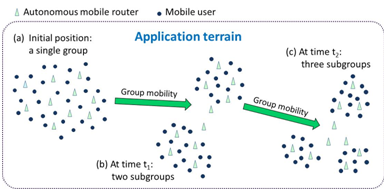Network partition is a primary factor that limits scalability of today’s mobile ad-hoc networks (MANETs). This limitation makes MANETs unsuitable for applications such as battlefield communications and crisis management, in which team members need to work in groups distributed in the application terrain. Network partition would prevent Inter-group communications required for the team collaboration. To address this limitation, we are investigating a new class of MANET, called Autonomous Mobile Ad-hoc Network (AMANET). AMANET is a mobile infrastructure with autonomous mobile router nodes equipped with positioning devices such as GPS. In addition to standard routing and relay functionality, these mobile router nodes (communication robots) have the intelligence to move with the network clients and adapt the network topology to provide optimal communication service (Figure 1). Most importantly, an AMANET tries to prevent network partitioning to ensure connectivity for all the users.


The topology adaptation of an AMANET is illustrated in Figure 2:
In Figure 2(a), the network users are initially assembled in a group to prepare for the mission. All the mobile routers are also positioned in the same proximity to provide communication service within this group.
In Figure 2(b), the mobile users move eastwards and split into two subgroups. The mobile routers, in this situation, reorganize themselves into a new topology to facilitate both intra-group and inter-group communications. Two mobile routers are used as the bridge to maintain connectivity between the two subgroups.
In Figure 3(b), the mobile users move further east and split into three subgroups due to the mission requirements. The mobile routers again adapt the network topology, this time with three bridging routers to ensure connectivity for all three subgroups.
An AMANET can be land-based, airborne, or underwater. As an example, autonomous quadropcopers powered by solar energy may be used as mobile routers. Given the dynamic of the application, additional routers may be launched on demand to maintain the desired communication coverage. The airborne network can reorganize itself to integrate the new routers automatically. In this presentation, we introduce this new communication paradigm and discuss directions for future research.
